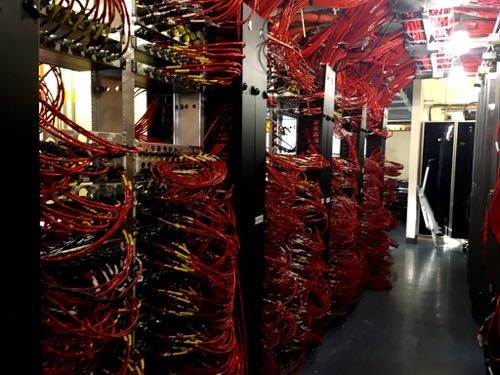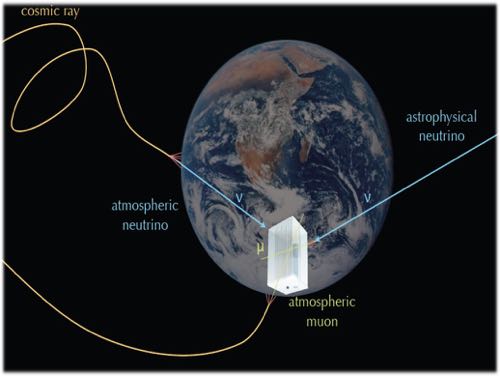Daily Data
There are nearly 3000 events detected by IceCube every second . That results in about 1 Terabyte of data per day.
 The server room in IceCube Lab. The cables carrying the electrical information from the DOMs enter the Lab as thick, Erikson cables, then split into the smaller red cables pictured here. The red cables lead to computers which process the data.
The server room in IceCube Lab. The cables carrying the electrical information from the DOMs enter the Lab as thick, Erikson cables, then split into the smaller red cables pictured here. The red cables lead to computers which process the data.
Now most of this data is background noise – particles other than neutrinos that we’re not so interested in. Computer programs filter these out and we’re left with about 70-100 Gigabytes of data each day. This data is sent to Madison, WI for further analysis.
IceCube is kind of known as a satellite hog here – remember, internet at the South Pole is only available when satellites are up. So it’s a pretty big deal that IceCube is allotted up to 100 Gigabytes per day of data transmission.
The end result is about 1000 atmospheric neutrinos detected per day and a few astrophysical neutrino detected per month.
Atmospheric Neutrinos
Atmospheric neutrinos come from a cosmic ray hitting Earth’s atmosphere.
A cosmic ray is essentially the nucleus of light elements (from Hydrogen to Iron) that comes from things like our Sun, supernovae, and really anything that has a magnetic field.
When a cosmic ray hits Earth’s atmosphere, a shower of new particles is created – some are neutrinos, many are not. Most of these particles don’t make it to Earth’s surface, but a few of them do. The non-neutrino particles are filtered out, and the neutrinos are saved for further analysis.
Because atmospheric neutrinos are created when a cosmic ray hits Earth’s atmosphere, we can only trace them back to their interaction in our atmosphere…not the supernovae it may have originally come from. But we still need to understand them because we need to know how to filter them out of the data.
Alternatively, looking at atmospheric neutrinos can help us learn about neutrino oscillations. You see there are three flavors of neutrinos– muon, tau and electron neutrinos (kind of like the flavors of ice cream). Neutrinos change back and forth between these flavors and we’re trying to better understand when, how and why. More to come on this in the next journal…
 An atmospheric neutrino and muon are coming from cosmic rays interacting with Earth's atmosphere. An astrophysical neutrino is coming directly from it's violent source in space. (Credit: IceCube Collaboration)
An atmospheric neutrino and muon are coming from cosmic rays interacting with Earth's atmosphere. An astrophysical neutrino is coming directly from it's violent source in space. (Credit: IceCube Collaboration)
Astrophysical Neutrinos
Every now and then (only a few times per month), we get lucky enough to see an astrophysical neutrino. Astrophysical neutrinos are coming to us straight from their source – gamma ray bursts, stars exploding and going supernovae, and active galactic nuclei to name a few.
Some of the atmospheric neutrinos come from above in the South Pole sky. Other atmospheric neutrinos come from below, originating at the North Pole and travelling all the way through the Earth. Some can even come from the sides!
Learning Something New
Both atmospheric and astrophysical neutrinos hold information about our universe. For a long time, astronomy was mostly done in the optical range (things you can see). But about a decade ago, we started to look at the universe through the lens of neutrinos (with IceCube) and just 1 year ago we added gravitational waves (with LIGO) to our tool belt. The more ways we can look at the universe, the more we can learn about it! Who knows what we’ll discover next!


Add new comment